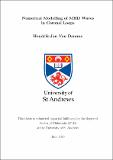Files in this item
Numerical modelling of MHD waves in coronal loops
Item metadata
| dc.contributor.advisor | De Moortel, Ineke | |
| dc.contributor.advisor | Pagano, Paolo | |
| dc.contributor.author | Van Damme, Hendrik-Jan | |
| dc.coverage.spatial | [17], 192 p. | en_US |
| dc.date.accessioned | 2020-12-07T15:24:36Z | |
| dc.date.available | 2020-12-07T15:24:36Z | |
| dc.date.issued | 2020-12-03 | |
| dc.identifier.uri | https://hdl.handle.net/10023/21057 | |
| dc.description.abstract | Waves in the solar corona have been investigated for many years, as a potential coronal heating mechanism and in the context of coronal seismology, and they play an important role in our understanding of the solar corona. In this thesis, we present the results of numerical simulations of transverse MHD waves in coronal loops. In a first study, we consider an atmospheric model for a coronal loop where the chromosphere is included as a simple mass reservoir and the effects of gravity, thermal conduction and optically thin radiation are taken into account, and we investigate the dissipation of phase-mixed, driven Alfvén waves and the subsequent heating and evaporation from the lower atmosphere. It has been argued that this evaporation can significantly affect the transverse density profile in the boundary of the loop, thereby changing the Alfvén speed gradient and the phase mixing process. We analyse the heating from the phase-mixed Alfvén waves and the evaporation and find that in our setup, with a high-frequency driver, the effect of the evaporation on the phase mixing process is negligible as a significant amount of the wave energy in the corona is lost to the lower atmosphere. Waves usually originate in the lower parts of the solar atmosphere, where the convective motions beneath the photosphere shuffle the magnetic field around, and they are then transmitted into the corona. However, recent observations have shown that transverse MHD waves can also be generated in-situ in the corona, by the collision of counter-propagating plasma clumps (coronal rain). When falling down, these coronal rain clumps can collide with upflows or other coronal rain clumps, and generate transverse oscillations. In order to investigate this mechanism, we develop a 2D model for the collision of counter-propagating plasma clumps based on detailed observations and statistical analysis of these events and study the generation of transverse MHD waves. We first study the relationship between various physical parameters of the clumps and the resulting oscillations and subsequently apply the model using observed coronal rain properties and investigate the likelihood of collisions and oscillations in coronal loops. In our simulations, we find that the properties of the oscillations are linked to the properties of the counter-propagating clumps, but also that coronal rain collisions and oscillations are rather unlikely in active region loops, due to the relatively large background pressure and magnetic field strength. | en_US |
| dc.description.sponsorship | "The research leading to the results presented within this thesis has received funding from the UK Science and Technology Facilities Council (Consolidated Grant ST/K0009 50/1), the European Union Horizon 2020 research and innovation programme (grant agreement No. 647214) and the Research Council of Norway through its Centres of Excellence scheme, project number 262622." -- Financial Support | en |
| dc.language.iso | en | en_US |
| dc.publisher | University of St Andrews | |
| dc.rights | Creative Commons Attribution-NonCommercial-NoDerivatives 4.0 International | * |
| dc.rights.uri | http://creativecommons.org/licenses/by-nc-nd/4.0/ | * |
| dc.subject | Magnetohydrodynamics (MHD) | en_US |
| dc.subject | Coronal loops | en_US |
| dc.subject | Coronal waves | en_US |
| dc.subject | MHD waves | en_US |
| dc.title | Numerical modelling of MHD waves in coronal loops | en_US |
| dc.type | Thesis | en_US |
| dc.contributor.sponsor | Science and Technology Facilities Council (STFC) | en_US |
| dc.contributor.sponsor | Horizon 2020 (Programme) | en_US |
| dc.contributor.sponsor | Norges forskningsråd | en_US |
| dc.type.qualificationlevel | Doctoral | en_US |
| dc.type.qualificationname | PhD Doctor of Philosophy | en_US |
| dc.publisher.institution | The University of St Andrews | en_US |
| dc.identifier.doi | https://doi.org/10.17630/sta/12 | |
| dc.identifier.grantnumber | Consolidated Grant ST/K0009 50/1 | en_US |
| dc.identifier.grantnumber | Grant agreement No. 647214 | en_US |
| dc.identifier.grantnumber | Project number 262622 | en_US |
The following licence files are associated with this item:
This item appears in the following Collection(s)
Except where otherwise noted within the work, this item's licence for re-use is described as Creative Commons Attribution-NonCommercial-NoDerivatives 4.0 International
Items in the St Andrews Research Repository are protected by copyright, with all rights reserved, unless otherwise indicated.


